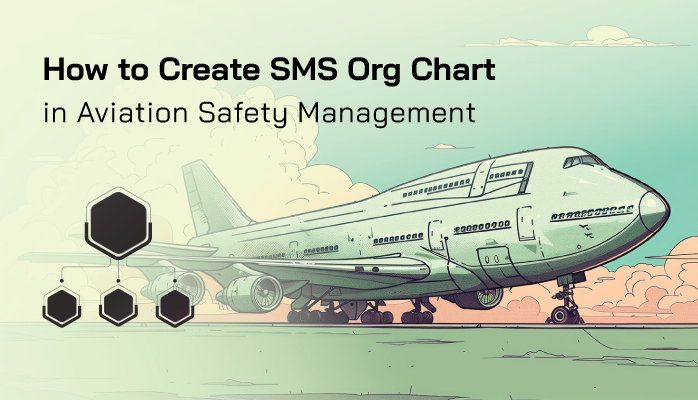What Is an SMS Org Chart in Aviation Safety Management

An SMS org chart in aviation safety management outlines the chain-of-command in your SMS. Safety org charts are a visual reference tool that outlines the structure of your SMS. SMS org charts are important because:
- Identifies roles in your organization;
- Shows communication lines; and
- Shows hierarchy of safety responsibility.
Safety org charts are something that every aviation SMS should include in their safety policy. Considering that having an org chart usually fulfills a number of compliance requirements, it is a good idea to create one.
Difference Between Company Org Chart and SMS Org Chart
Your SMS org chart will not be the same as your company org chart. Whereas your company org chart outlines the business structure and responsibilities, your SMS org chart pertains only to your SMS. In other words, safety information and tasks are handled independently of organizational structure.
That being said, your SMS org chart will likely look fairly similar to your company org chart.
- People with responsibility in your company will also likely have a responsibility in your SMS; and
- The size and scope of your SMS org chart will be similar to the size and scope of your business org chart.
So whereas SMS and company org charts serve different functions, it’s helpful to model your SMS chart after your company chart.
Steps for Creating SMS Org Charts
Steps for creating SMS org charts are straightforward:
- Establish roles in your SMS;
- Identify individuals in key roles;
- Identify communication channels between roles;
- Find a tool, such as MS Word, Excel, Visio, etc.; and
- Map out org chart.
Creating Roles in Aviation SMS

SMS org charts are role-based. If you haven’t established roles, you will need to create them. Creating involves having a clear understanding of the different safety responsibilities your organization requires. Other factors that affect which roles you will have:
- Size of your reorganization;
- Resources available to your SMS (do you have SMS software, is it a spreadsheet-based SMS?);
- Level of buy-in from employees;
- Existing processes; and
- Type of industry you serve (airport, airline, helicopter, etc.).
A good rule of thumb is to:
- Make a list of all safety responsibilities;
- Start out with the essential roles;
- List responsibilities for each role;
- See which important roles would be good inclusions for your existing processes;
- List responsibilities for each important role; and
- Then see which responsibilities in your organization are not filled by the roles you just documented.
Related Articles on Organizational Charts in Aviation SMS
- Introduction to Organizational Charts in Aviation SMS
- How to Create an Org Chart for Aviation Safety Programs
- Top Charts and Tools to Help With Risk Analysis in Aviation SMS
Essential Roles to Include in Your SMS Org Chart
Essential roles that should be included in your org chart are.
- Accountable Executive role;
- Safety Manager role;
- SMS User role;
- Confidential Manager role;
- Data Entry role; and
- Subject-Matter Expert role (usually called Department Head role).
You might also include other roles in your org chart, but you should definitely have the above roles at the least. For roles like the accountable executive, safety manager(s), confidential manager, and department heads, make a list of employees who have that role.
Map Out SMS Org Chart Roles and Write Lines
Next, map out the roles in your SMS and draw lines in a pyramid-like structure to connect the roles.
Connecting roles involves:
- Creating hierarchy;
- Showing direct lines of communication; and
- Putting it on paper.
Mapping out your SMS chart and writing lines between roles should allow someone who is not familiar with your organization to immediately understand:
- Who’s responsible for safety;
- Who to talk to based on their role; and
- Who’s making safety decisions?
Last updated March 2025.





